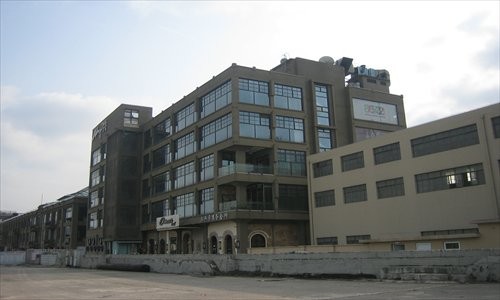
The group of warehouses sit along Waimalu Road. Photo: Li Yuting/GT
Nearly as fast as expansive skyscrapers reshape the skyline above the Huangpu River, ambitious landmark clusters are forming along the Bund and its surrounding areas - creating new backdrops and offering hip, artsy city dwellers in search of new views myriad selections for dining, shopping and discovering the city's storied history and impressive architecture.
On the southern reaches of the up-and-coming area, The Cool Docks has stretched the Bund sightseeing path beyond the core with rapid development in recent years. Hanging a left at the end of a leisurely minutes-long stroll on Zhongshan Road South in Huangpu district will lead those on foot to Waimalu Road, where an ensemble of five renovated old warehouses sit.
Piers of yesterday
Located in the former British concession, the archetype of The Cool Docks is that of the now-dismantled Shiliupu Pier (literally "16 retail stores" in Chinese) - a general term referring to the array of piers that have spanned several periods of history.
Shiliupu Pier came into form as early as the reign of Emperor Xianfeng in the Qing Dynasty (1644-1911), according to the city's record books, and during the Republic of China (1912-1949), it thrived as the top dock in the Far East and trade center of China until the 1980s.
Before the War of Resistance against Japanese Aggression (1937-45), Shiliupu boasted prosperous trade exchanges with stalls providing a range of goods, from seafood to beans and fruits and silver.
After the commercial port began opening up in 1843, it went on to see Shanghai's development, which saw the rise of some of the most powerful names in the city, including Du Yuesheng (1888-1951) in the early 20th century. A rich, influential boss of Shanghai Green Gang, dominating trade, transportation and gambling circles in his time, he began in earnest, working at one of the dock's fruit shops.
Adjacent to the yacht harbor at the Expo Park, nowadays The Cool Docks is enjoyed by visitors mostly for its well-kept shikumen, or old Shanghai-style houses, the likes of which can also be found in Xintiandi; and its nostalgic 1930s warehouses along the river.
A storied past
The relatively new Sunny Beach at The Cool Docks, however, is slowly gaining in popularity. At the intersection of Waimalu Road and Maojiayuan Road, the artificial sandy beach that opened a year ago seeks tanning lovers for a 50-yuan ($7.91) entry fee. A complimentary soft drink comes with the invite to save parched lips from drying out under the sun's powerful rays during opening hours from 10 am to 10 pm.
Meters away and jutted against the city's flood-prevention wall along Waimalu Road, the old warehouses feature rooftops being exploited to function as viewing platforms. Restored with the intent of keeping their original forms, they maintain shikumen-style elements with porcelain blue-colored bricks, columns and balconies.
Inside, commercial businesses are snatching up space and adding to a growing makeup of creative tenants on the street keen on embracing bold concepts while remembering its former glories on the riverside pathway.
The earliest of the five-storey buildings covering some 5,000 square meters is No.1 Warehouse. Built in 1936 with a cylinder fa ade dominating its exterior, it was previously owned by shipping tycoon Lu Zuofu (1893-1952). The venue has since been renovated into modern existence as a high-end night club.
Shanghai Fuxing Port or No.2 Warehouse, meanwhile, has maintained its "grand" reputation throughout the years to attract a niche group of fine-dining restaurants and fashion boutique shops. It was known in the height of its day as the "Grand Warehouse" until 1954. It was later redesigned in 1986 to give it an aesthetic more in tune with architectural trends of the 1980s. Most recently, it was given a face-lift by a local commercial developer to coincide with the World Expo 2010 in Shanghai.
As for bar-goers tired of the typically posh and sterile development of the city's Bund bar scene, No.3 Warehouse and its compilation of drinking venues, may be worth a stop.
The first floor of the building first owned by renowned Chinese entrepreneur and social activist Yu Qiaqing (1867-1945) invites patrons in with bilingual exhibition Dork Time on 601 Waimalu Road. The free display features prints of historic photos and video documentaries, which trace the history of Shiliupu and the warehouses.
Following a reminiscent tour of storied pasts, the South Bund presents a "Xintiandi" step forward into modern Shanghai, where rows of ritzy restaurants and glossy windows with tailored threads behind them, await nouveau riche Chinese.
The center of the square complex - filled with cafés, boutique hotels, art studios and galleries - is hard to miss with an overlooking fountain display highlighting "The Cool Docks" in Chinese and English.
Nineteen buildings are organically spread out, most of which have been renovated or constructed to mirror the archaic feel of the area though their look is certainly more polished - with the exception of three modest, semidetached houses, which have not caved to commercial appeal. The private homes remain protected under the banner "Shikumen Old Street."

Copyright ©1999-2011 Chinanews.com. All rights reserved.
Reproduction in whole or in part without permission is prohibited.